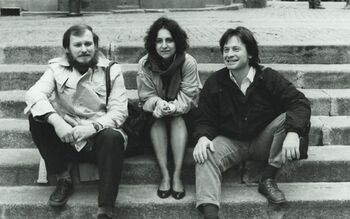Difference between revisions of "Dunja Donassy"
| Line 1: | Line 1: | ||
| − | The architect and artist Dunja Donassy-Bonačić (1945, Zagreb) studied architecture and urban planning at the University of Zagreb. In 1971 she founded together with [[Vladimir Bonačić]] and [[Miro A. Cimerman]] founded the [[bcd|»bcd«]] (later: »bcd CyberneticArt team«). In 1972, she moved with Bonačić and Cimerman to Jerusalem, where she first worked as an assistant at the Bezalel Academy of Arts & Design in the Department of Industrial & Environmental Design. In the same year, »bcd« initiated the international »Jerusalem Program in Art and Science« at the Bezalel Academy of Arts & Design in cooperation with UNESCO. After a brief return to Croatia in 1978, she moved to Germany in 1979. Starting in 1980, together with Bonačić and Cimerman, she developed innovative forms of computer-based information visualization for German television. | + | [[Image:Bcd_Cybernetic_Art_team.jpg|thumb|350px|bcd Cybernetic Art team. [[Miro A. Cimerman]], Dunja Donassy, [[Vladimir Bonačić]] (left to right). [https://zkm.de/en/event/2019/11/vladimir-bonacic-bcd-cyberneticart Source].]] |
| + | |||
| + | The architect and artist '''Dunja Donassy-Bonačić''' (1945, Zagreb) studied architecture and urban planning at the University of Zagreb. In 1971 she founded together with [[Vladimir Bonačić]] and [[Miro A. Cimerman]] founded the [[bcd|»bcd«]] (later: »bcd CyberneticArt team«). In 1972, she moved with Bonačić and Cimerman to Jerusalem, where she first worked as an assistant at the Bezalel Academy of Arts & Design in the Department of Industrial & Environmental Design. In the same year, »bcd« initiated the international »Jerusalem Program in Art and Science« at the Bezalel Academy of Arts & Design in cooperation with UNESCO. After a brief return to Croatia in 1978, she moved to Germany in 1979. Starting in 1980, together with Bonačić and Cimerman, she developed innovative forms of computer-based information visualization for German television. | ||
Dunja Donassy-Bonačić works in the field of cybernetic art (graphics, sculptures, installations) and pursues the concept of a balance between science, information technology and art. She also applied principles of cybernetic art in the development of computer-based designs for communication and opinion research in public media. [https://zkm.de/en/event/2019/11/vladimir-bonacic-bcd-cyberneticart (2019)] | Dunja Donassy-Bonačić works in the field of cybernetic art (graphics, sculptures, installations) and pursues the concept of a balance between science, information technology and art. She also applied principles of cybernetic art in the development of computer-based designs for communication and opinion research in public media. [https://zkm.de/en/event/2019/11/vladimir-bonacic-bcd-cyberneticart (2019)] | ||
Revision as of 19:31, 30 October 2022
The architect and artist Dunja Donassy-Bonačić (1945, Zagreb) studied architecture and urban planning at the University of Zagreb. In 1971 she founded together with Vladimir Bonačić and Miro A. Cimerman founded the »bcd« (later: »bcd CyberneticArt team«). In 1972, she moved with Bonačić and Cimerman to Jerusalem, where she first worked as an assistant at the Bezalel Academy of Arts & Design in the Department of Industrial & Environmental Design. In the same year, »bcd« initiated the international »Jerusalem Program in Art and Science« at the Bezalel Academy of Arts & Design in cooperation with UNESCO. After a brief return to Croatia in 1978, she moved to Germany in 1979. Starting in 1980, together with Bonačić and Cimerman, she developed innovative forms of computer-based information visualization for German television.
Dunja Donassy-Bonačić works in the field of cybernetic art (graphics, sculptures, installations) and pursues the concept of a balance between science, information technology and art. She also applied principles of cybernetic art in the development of computer-based designs for communication and opinion research in public media. (2019)
- Links
